The AMD Threadripper 2990WX 32-Core and 2950X 16-Core Review
by Dr. Ian Cutress on August 13, 2018 9:00 AM ESTHEDT Benchmarks: Encoding Tests
With the rise of streaming, vlogs, and video content as a whole, encoding and transcoding tests are becoming ever more important. Not only are more home users and gamers needing to convert video files into something more manageable, for streaming or archival purposes, but the servers that manage the output also manage around data and log files with compression and decompression. Our encoding tasks are focused around these important scenarios, with input from the community for the best implementation of real-world testing.
Handbrake 1.1.0: Streaming and Archival Video Transcoding
A popular open source tool, Handbrake is the anything-to-anything video conversion software that a number of people use as a reference point. The danger is always on version numbers and optimization, for example the latest versions of the software can take advantage of AVX-512 and OpenCL to accelerate certain types of transcoding and algorithms. The version we use here is a pure CPU play, with common transcoding variations.
We have split Handbrake up into several tests, using a Logitech C920 1080p60 native webcam recording (essentially a streamer recording), and convert them into two types of streaming formats and one for archival. The output settings used are:
- 720p60 at 6000 kbps constant bit rate, fast setting, high profile
- 1080p60 at 3500 kbps constant bit rate, faster setting, main profile
- 1080p60 HEVC at 3500 kbps variable bit rate, fast setting, main profile
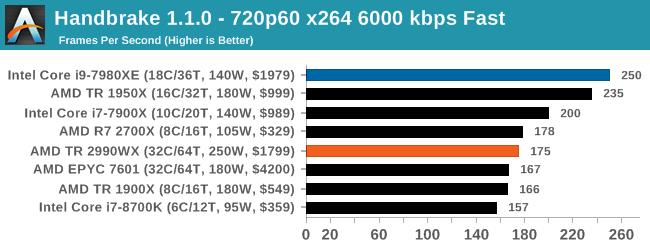
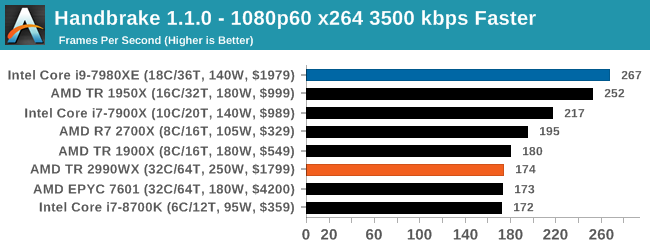
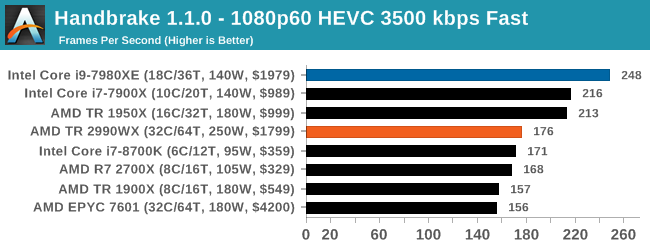
Video encoding is always an interesting mix of multi-threading, memory latency, and compute. The Core i9, with AVX2 instructions, sets a commanding lead in all three tests. The AMD processors seem to fluctuate a bit, with the 1950X and 2700X being the best of the bunch. Unfortunately we didn’t get 2950X results in our initial runs, but I would expect it to be competitive with the Core i9 for sure, given where the 1950X is. However the 2990WX does fall behind a bit.
7-zip v1805: Popular Open-Source Encoding Engine
Out of our compression/decompression tool tests, 7-zip is the most requested and comes with a built-in benchmark. For our test suite, we’ve pulled the latest version of the software and we run the benchmark from the command line, reporting the compression, decompression, and a combined score.
It is noted in this benchmark that the latest multi-die processors have very bi-modal performance between compression and decompression, performing well in one and badly in the other. There are also discussions around how the Windows Scheduler is implementing every thread. As we get more results, it will be interesting to see how this plays out.
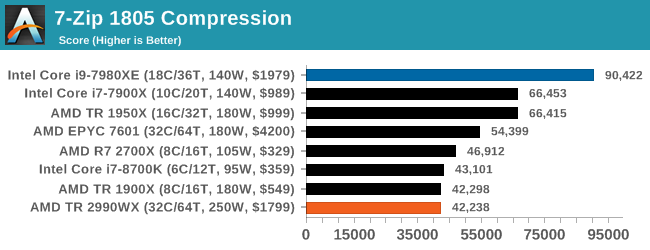
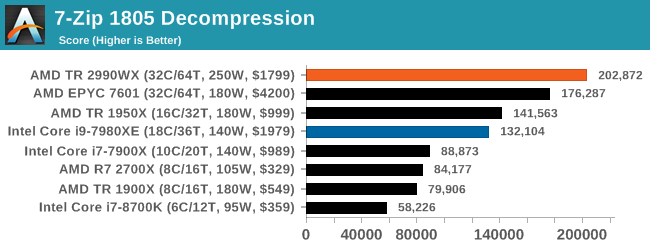
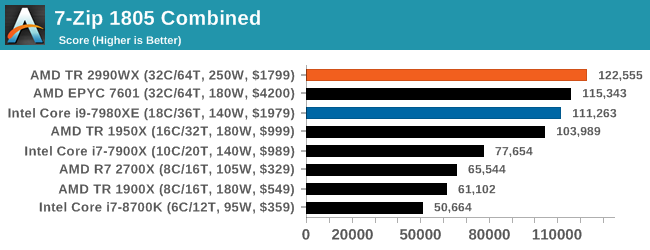
Oh boy, this was an interesting set of tests. When we initially published this review, without commentary, the compression graph with the 2990WX at the bottom was shared around social media like crazy, trying to paint a picture of why AMD performance isn’t great. It was also used in conjuction with Phoronix’s tests, that showed a much better picture on Linux.
But what confuses me is that almost no-one also posted the decompression graph. Here AMD’s 32-core processors take a commanding lead, with the 16/18-core parts being the best of the rest.
If you plan to share out the Compression graph, please include the Decompression one. Otherwise you’re only presenting half a picture.
WinRAR 5.60b3: Archiving Tool
My compression tool of choice is often WinRAR, having been one of the first tools a number of my generation used over two decades ago. The interface has not changed much, although the integration with Windows right click commands is always a plus. It has no in-built test, so we run a compression over a set directory containing over thirty 60-second video files and 2000 small web-based files at a normal compression rate.
WinRAR is variable threaded but also susceptible to caching, so in our test we run it 10 times and take the average of the last five, leaving the test purely for raw CPU compute performance.

A set of high frequency cores and good memory is usually beneficial, but sometimes some more memory bandwidth and lower latency helps. At the top is AMD’s R7 2700X, with the Intel 10-core just behind. I’m surprised not to see the 8700K in there, perhaps its six cores is not enough. But the higher core count AMD parts struggle to gain traction here, with the 32-core parts taking some sweet time to finish this test.
AES Encryption: File Security
A number of platforms, particularly mobile devices, are now offering encryption by default with file systems in order to protect the contents. Windows based devices have these options as well, often applied by BitLocker or third-party software. In our AES encryption test, we used the discontinued TrueCrypt for its built-in benchmark, which tests several encryption algorithms directly in memory.
The data we take for this test is the combined AES encrypt/decrypt performance, measured in gigabytes per second. The software does use AES commands for processors that offer hardware selection, however not AVX-512.
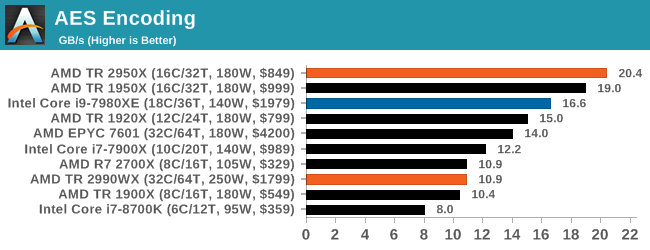
Normally we see this test go very well when there are plenty of cores, but it would seem that the bi-modal nature of the cores and memory controllers in the 2990WX gives a poor result. The EPYC 7601, with eight memory controllers, does a better job, however the 1950X wins here. The 2950X, where all cores have a similar access profile, scores top here, well above Intel’s 18-core Core i9.










171 Comments
View All Comments
jospoortvliet - Saturday, August 18, 2018 - link
https://www.phoronix.com/scan.php?page=article&... has some.nul0b - Monday, August 13, 2018 - link
Ian please define how exactly you're calculating and deriving uncore and IF power utilization.alpha754293 - Monday, August 13, 2018 - link
I vote that from now on, all of the CPU reviews should be like this.Just raw data.
Lolimaster - Monday, August 13, 2018 - link
To resume:Intel's TDP is a blatant lie, it barely keeps at TDP at 6c/6t, meanwhile AMD stick on point or below TDP with their chips, boost included :D
Lolimaster - Monday, August 13, 2018 - link
Selling more shares from $1.65 now to $19 :DAMD Threadripper 2, ripping the blue hole.
Lolimaster - Monday, August 13, 2018 - link
It seems geekbench can't scale beyond 16cores.Lolimaster - Monday, August 13, 2018 - link
WHERE IS CINEBENCH?Lolimaster - Monday, August 13, 2018 - link
And I mean CB15Also, for some reason CB11.5 MT seems to be broken for TR, it stops caling at 12cores.
mapesdhs - Monday, August 13, 2018 - link
CB R15 is suffering issues aswell these days, at this level it can exhibit huge variance from one run to another.eastcoast_pete - Monday, August 13, 2018 - link
Thanks Ian, great article, look forward to seeing the full final version!My conclusions: All these are workstation processors, NOT for gaming; the Ryzen 2700X and the upcoming Intel octacore 9000 series are/will be better for gaming, both in value for money and absolute performance. That being said, the TR 2950X could be a great choice, if your productivity software can make good use of the 16 cores/32 threads, and if that same software isn't written to make strong use of AVX 512. If the applications that you buy these monsters can make heavy use of AVX 512, Intel's chips are currently hard or impossible to beat, even at the same price point. That being said, a 2950X workstation with 128 or 256 Gb of RAM (in quad channel, of course), plus some fast PCIe/NVMe SSDs and a big & fast graphics card would make an awesome video editing setup; and, the 60 PCIe channels would come in really handy for add-in boards. One fly in the ointment: AMD, since you're hamstringing TR with only quad-channel, at least let us use faster DDR4; how about officially supporting > 3.2 Ghz?
Unrelated: Love the testing setup where the system storage SSD ( 1TB) is the same size as the working memory (1 TB). With one of these, you know you're in the heavyweight division.
@Ian: I also really appreciate the testing of power draws by cores vs. interconnecting fabric. I also believe (as you wrote) that this is a much underappreciated hurdle in simply escalating the number of cores. I also wonder a. How is that affecting ARM-based multicore chips, especially once we are talking 32 cores and up, as for the chips intended for servers? and b. Is that one of the reasons (or THE reason) why ARM-based manycore solutions have not been getting much traction, and why companies like Qualcomm have stopped their development? Yes, the cores might be very efficient, but if those power savings are being gobbled up by the interconnects, fewer but broader and deeper cores might still end up winning the performance/wh race.
If you and/or Ryan (or any of your colleagues) could do a deep dive into the general issue of power use by the interconnecting fabric and the different architectures, I would really appreciate it.